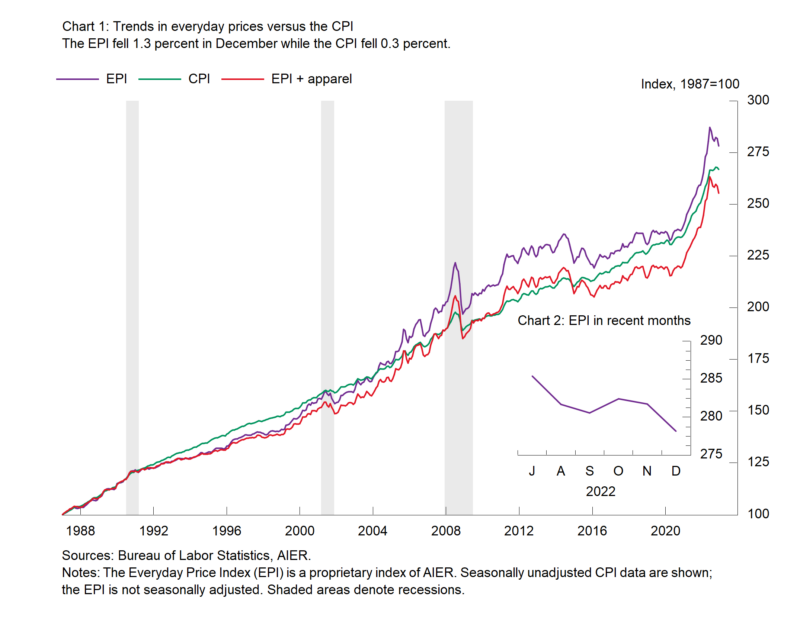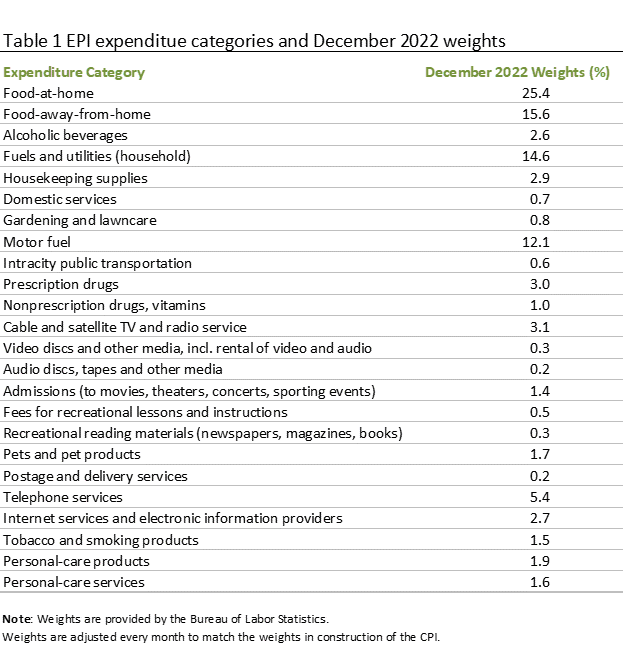AIER’s Everyday Price Index Falls for the Fifth Time in Six Months
AIER’s Everyday Price fell 1.3 percent in December following a decline of 0.2 percent in November. December was the fifth decline in the last six months. The Everyday Price Index is up 7.3 percent from a year ago, the slowest since September 2021. Food and home utilities were the top contributors to the rise in December but were more than offset by a plunge in motor fuel prices.
Motor fuel prices, which are often a significant driver of the monthly changes in the Everyday Price index because of the large weighting in the index and the volatility of the underlying commodity, fell 12.4 percent for the month (not seasonally adjusted), subtracting 155 basis points. Prices for household fuels and utilities and food away from home rose 0.4 percent for the month, while prices for food at home rose 0.3 percent. Combined, those three categories added 19 basis points to the overall index.
The Everyday Price Index, including apparel, a broader measure that includes clothing and shoes, fell 1.3 percent in December, also the fifth decline in the last six months. Over the past year, the Everyday Price Index, including apparel, is up 7.0 percent, the lowest since September 2021.
Apparel prices fell 1.7 percent on a not-seasonally-adjusted basis in December. Apparel prices tend to be volatile on a month-to-month basis. From a year ago, apparel prices are up 2.9 percent.
The Consumer Price Index, which includes everyday purchases and infrequently purchased, big-ticket items and contractually fixed items, fell 0.3 percent on a not-seasonally-adjusted basis in December. Over the past year, the Consumer Price Index is up 6.5 percent.
Within the CPI, energy posted a 6.1 percent drop on a not-seasonally-adjusted basis while food had a 0.3 percent increase. The Consumer Price Index, excluding food and energy, rose 0.2 percent for the month (not seasonally adjusted) while the 12-month change came in at 5.7 percent. The 12-month change in the core CPI was just 1.3 percent in February 2021 and 2.3 percent in January 2020, before the pandemic.
After seasonal adjustment, the CPI fell 0.1 percent in December while the core increased by 0.3 percent for the month. Over the last three months, the CPI is up at a much slower 1.8 percent annualized pace while the core is up at a 3.1 percent pace.
Within the core, core goods prices fell 0.3 percent in December, the third decline in a row, putting the three-month annualized rate of change at -4.8 percent. Core goods prices were up 2.1 percent from a year ago.
Core services prices were up 0.5 percent for the month and 7.0 percent from a year ago. Among core services, gainers include shelter, which accounts for 32.9 percent of the CPI, up 0.8 percent for the month. The shelter index increased 7.5 percent over the last year, accounting for a substantial share of the total increase in all items less food and energy.
The index for all items excluding food, energy, and shelter, about 45 percent of the CPI, fell 0.1 percent in December, the third drop in a row. The most recent three-month annualized rate is -1.0 percent, indicating that slightly less than half of the CPI has experienced persistent deflation over the past three months.
There is mounting evidence of a significant deceleration in the rate of price increases for many goods and services, though some rates of price increase remain elevated. Sustained elevated price increases are likely distorting economic activity by influencing consumer and business decisions. Furthermore, price pressures have resulted in an aggressive Fed tightening cycle, raising the risk of a policy mistake. The fallout surrounding the Russian invasion of Ukraine continues to disrupt global supply chains while labor shortages and turnover continue to challenge businesses. Furthermore, some recent measures of economic activity are weakening. All of these are sustaining a high level of uncertainty for the economic outlook. Caution is warranted.








